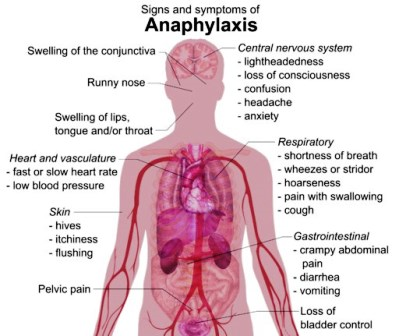This article contains affiliate links. If you make a purchase after clicking on a link I may earn a small commission at no extra cost to you.
How to Identify the Causes of Anaphylaxis
Investigating an attack of anaphylaxis can take lots of detec-tive work, because the cause may be far from obvious. Anaphylaxis can be mistaken for fainting (“vasovagal syncope”), a more familiar but usually harmless event. Fainting is managed by simply helping the person lie down.
Penicillin is the most frequent drug cause of anaphylaxis. It is closely followed by cephalosporin (another antibiotic). Insect stings are the next most frequent cause — in particular the venom of the Hymenoptera class, which includes bees, wasps, yellow jackets and hornets — followed by foods as the next most frequent cause. 
The head of one emergency department notes that those rushed in with anaphylaxis from food are most often people allergic to peanuts and seafood.
[box style=”rounded”]About 40 to 50 percent anaphylaxes from food allergies, and the rest from a variety of triggers, particularly insect stings, penicillin and vaccines, or they are set off by skin prick tests or allergy shots with a provocative allergen.[/box]
No one should have allergy tests or injections in any location without full emergency backup.
[box style=”rounded”]”It’s essential,” notes one allergist, “to have life-saving aids on hand when doing allergy tests or giving allergy shots.[/box]
People must be observed for a minimum of 20 minutes after an allergen injection, to make sure no adverse reactions occur — watching for signs such as flushing, swelling or itchiness.”
But that doesn’t mean allergy tests should be avoided. The director of an anaphylaxis clinic notes that “one big favor you can do for someone who has experienced allergic shock is to help identify its cause, so the precipitant can be avoided. Someone who doesn’t know what to avoid can suffer anaphylaxis at any time.”
Who Is Most at Risk?
Roughly 1 percent of the North American population is at risk of anaphylaxis. Near-fatal or fatal anaphylactic episodes are most common among adults, although children may be at as great, or greater, risk because of their inability to recognize and act on the emergency.
In children, anaphylactic episodes tend to produce fewer cardiovascular (blood system and heart) problems and more airway obstruction, swelling and hives.
People who are taking beta-blocker drugs for high blood pressure or other disorders are at increased risk of anaphylaxis, because they will not respond to epinephrine injected as an antidote. If you have experienced allergic reactions, you may be advised to use other drugs instead of beta blockers.
